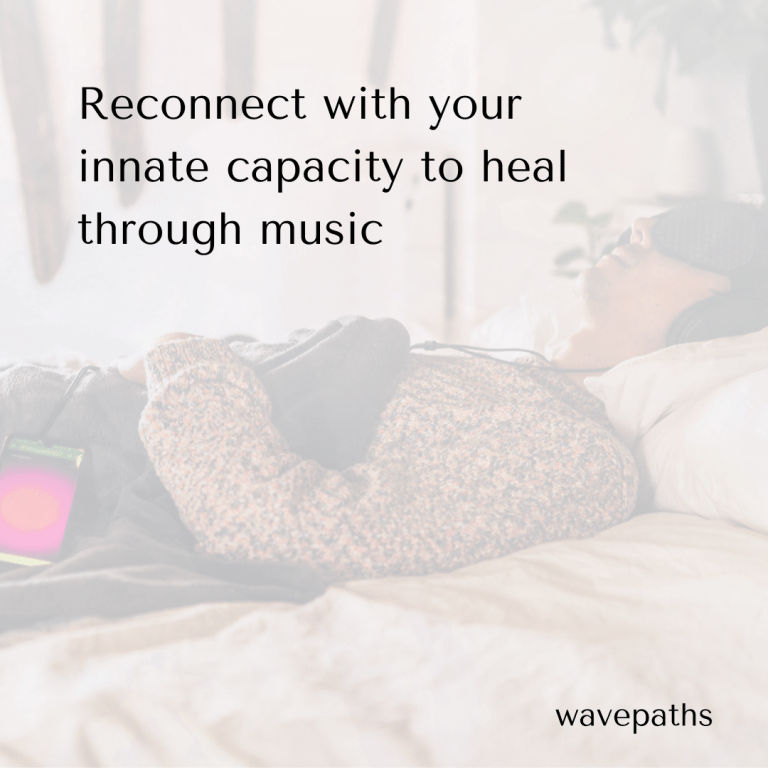The Ultimate Guide to Deep Listening with Wavepaths
What is Deep Listening?
In simple terms, deep listening is a way of listening to ourselves and what our bodies and minds have to say.
There are different ways to practice deep listening. Here at Wavepaths, we provide deep listening as a way of connecting to yourself through music.
There are many ways to listen to music, yet rarely do we give ourselves permission to listen to music with our full attention.
At Wavepaths, we call music the language of emotion because music has the power to give voice to deeper needs, and offers a medium through which to truly listen to yourself.
Wavepaths was founded on the insight that when we do allow ourselves to listen more deeply to music, we are in essence listening more deeply to ourselves, in particular, to those parts of ourselves that we may not always see, acknowledge and accept.
Research shows that the right music, when you listen with focus and intention, supports meaning-making, emotionality, and mental imagery – the same therapeutic processes associated with psychedelic therapy and other experiential therapies
I can access aspects of myself that aren’t normally available with Wavepaths
– Christopher Gardiner
What benefits come from Deep Listening?
The act of being listened to can be profoundly healing.
When you listen to yourself, multiple benefits can begin to surface, including but not limited to:
- A sense of calm
- Mindfulness
- Focus
- Relaxation and release
- Connection with self
- Personal insight
- Emotional processing, and more.
People who have experienced Deep Listening with Wavepaths often report a sense of deep rest and relaxation after a session (which can also lead to a really good night’s sleep).
Wavepaths higher intensity deep listening sessions are often used for emotional processing. Higher intensity sessions can be tiring, but ultimately lead to better emotional health and wellbeing as repressed emotions are felt and expressed during the session, leading to a deeper connection with self, personal insight and understanding. Participants working with higher intensity music often benefit from integrating their experience.
At Wavepaths, we believe agency is a prerequisite for growth and that music is a powerful tool to navigate your own path to healing. Deep listening with music helps to create compassionate connections and facilitate personally meaningful experiences to improve mental health and well-being.
While playlists open up countless avenues of experience for the modern listener and are lauded for their accessibility, they may not always be suited to the highly dynamic, fluid, profoundly personal and often unpredictable experience of each individual during a session.
Who is Deep Listening for?
Deep listening is for anyone who would like to experience the therapeutic benefits of music and a deeper connection with self.
Music can be an accessible way, along with a trained guide, to support mental health and wellbeing at home.
Deep listening can be a stand-alone-practice or experienced alongside other approaches to self-discovery such as yoga, breathwork, meditation or psychedelic-integration.
It is important to be aware of some contra-indications, especially for deep listening sessions that use higher intensity music. Those who are currently experiencing acute emotional distress, such as post-traumatic stress disorder, should seek the advice of a mental health practitioner before listening to one of Wavepaths’ sessions.

What is guided deep listening like with Wavepaths?
One-to-one and group guided experiences, featuring music fully personalised and adapted to your unique preferences and needs, are offered subject to limited availability. You can learn more about these and enquire here.
“Thank you it was one of 5 most incredible
musical experiences in my life!”
– End of Year Deep Listening Attendee
Go where playlists can’t take you
At Wavepths, our approach is developed as a simple and accessible way for you to build a little more space within your days. A space in which you can arrive, return and be at ease with your ever evolving experience of yourself and of your life.
Wavepaths deep listening sessions are born out of research on the role of music in psychedelic therapy. Each session is completely unique, created for you live, in the moment from music composed by artists. The artists we work with produce music specially for Wavepaths, in support of specific therapeutic intentions. Learn more about our award-winning artists here.
Wavepaths music is procedurally generated and works by intelligently mixing collections of sounds in real time from an expanding library of live-recorded, proprietary content that embody certain emotional themes.
A generative approach allows Wavepaths’ repertoire to evolve continuously, produce unique, unrepeatable music, and enables fluid and live adaptability features that are central to a person-centred approach. Generative music supports a process of musical arrangement that is spontaneous, interflowing and reflective of the sounds and rhythms of nature.
How to make the most of your Deep Listening practice
To make the most of your deep listening practice:
Prepare your space
- The ideal environment for deep listening is a comfortable, private space that will be free from disturbance for the duration of the session.
- We recommend lying down on a supportive surface such as a yoga mat on the floor
- Try using a cushion or pillow to support your head and under your knees
- Avoid using your bed or other areas that you associate with sleep
- We recommend using eye shades as this supports full immersion in the music
- Consider having a blanket at hand as sometimes listeners become cold mid-session
- When using your phone, put your device in ‘Do Not Disturb’ mode to prevent interruption from notification sounds (on Windows this feature is called ‘Focus Assist’).
- Wear good quality headphones (preferably wired to avoid low battery warnings or powering down mid session).
- Make sure the volume is comfortably loud so that the music fills your awareness.
- If using Bluetooth headphones ensure they are not paired with any other nearby devices and that no other browser tabs are open on your devices.
- Test your audio equipment prior to the session.
- Deep Listening can evoke strong experiences, take sufficient self-care preparing yourself and after the session
- Do not rush in and out of the session. Leave time before and after to ease the transition between the experience and the rest of your day.
- Engage wholeheartedly and dedicate your full attention to the experience with openness and curiosity.
- Set time aside to reflect on what is most present within yourself and what you are hoping for the experience will bring to you
Ask yourself:
- What are you most able to be open to and present to in your life now?
- What do you find most difficult to accept in your life right now?
- Where in your life are you seeking change?
Be Curious
Focus on nothing else than the experience of the music.
Be Open
Accept without judgement the entirety of the experience.
Be Carried
Experience the entirety of the unfolding music.
“I sometimes refer to music as a transformative technology because it’s a technology that changed the fabric of our society, our culture and human nature. It has literally changed our brains.”
– Dr. Mendel Kaelen
In Review: How to get started with Deep Listening today
Deep listening is a way of listening to ourselves and what our bodies and minds have to say. A deep listening session can be profoundly healing and promote a state of calm and relaxation, facilitate emotional processing, and foster a deeper connection with self.
Try Wavepaths for personal use today and start to cultivate your own sound healing practice.



